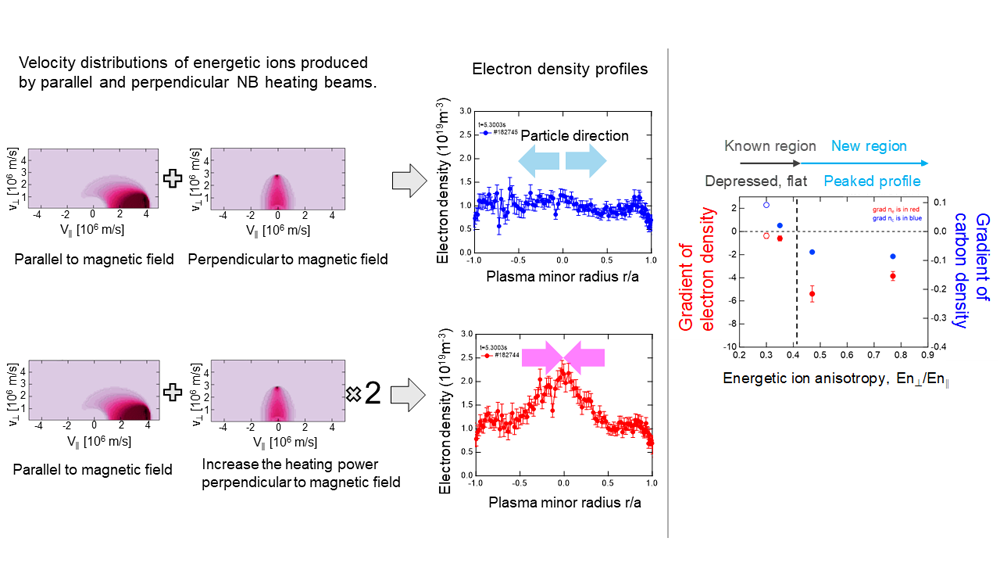Discovery of spontaneous inflow and outflow states of high-temperature plasma by energetic ions
In fusion research, the performance of a plasma confined by a magnetic field is determined by its density, temperature, and confinement time, with these values varying widely depending on the plasma’s heating conditions. A high-performance fusion reactor requires improving the confinement of particles and heat in the plasma and sustaining a high density and temperature at the center of the plasma where the fusion reaction occurs. In this study, by using a neutral beam injection heating system *1 to heat the plasma and changing the ratio of beam powers tangential and perpendicular to the magnetic field, we observed that the inflow and outflow of high-temperature plasma is spontaneously regulated by a unique state of energetic ions. This breakthrough could lead to the development of high-performance plasma, reduce the size of fusion reactors, increase the output of fusion power, and improve the control of plasma-burning conditions.

The LHD is equipped with five neutral beam (NB) injection heating systems for plasma heating. Injectors NB#1 to NB#3 deliver beams tangentially to the magnetic field, while NB#4 and NB#5 inject beams perpendicularly. Despite variations in the power ratio between the tangential and perpendicular injections, the ion temperature profile remained unchanged. However, the left figure illustrates both peaked (red) and flat (blue) electron density profiles.
Adjustments in the tangential to perpendicular energetic-ion ratio alter the velocity distribution *2 from isotropic to anisotropic. We explored how the density profile depends on the state of these energetic ions by analyzing the ratio of the stored energies in the perpendicular and parallel components, designated as En⊥/En|| from the injected beam power of NB#1–NB#5 (refer to right figure). Modifying the anisotropy within a range from En⊥/En|| = 0.3 - 0.8 showed that En⊥/En|| < 0.4 led to a flat electron density profile, while En⊥/En|| > 0.4 resulted in centrally peaked electron density profiles. Subsequently, the density profile of carbon ions was examined by externally injecting a carbon pellet and observing the ion behavior. The profile was centrally depressed in the conventional experimental range of En⊥/En|| < 0.4, yet peaked in the new one where En⊥/En|| > 0.4.
Our findings reveal that a significant transport in the plasma inflow/outflow rates change spontaneously with the presence of anisotropic energetic ions. This discovery has profound implications for the regulation of a fusion plasma's confinement region. Further investigations into the effects of energetic ions were conducted using simulation calculations. Initially, we analyzed the electric field in the radial direction at the plasma core, which simulated −5 kV/m, consistent with measurements from the heavy ion beam probe *3 (HIBP). Although an electric field of this strength is unlikely to influence particle flow significantly, further analysis of particle inflow and outflow due to turbulence was conducted. The results suggest that turbulence may influence both peaked and flat density profiles.
Our discovery elucidates that the direction and volume of particle inflow and outflow within the confinement region of fusion plasma can be effectively regulated by applying the anisotropic nature of energetic ions and is a significant step forward. This finding opens up new avenues for research and development in the field of plasma physics and nuclear fusion. In the future, we aim to clarify the new physics mechanism behind this discovery. We will then further develop our research to contribute to higher performance of fusion reactor plasmas, downsizing of fusion reactors, improvement of energy output, and control of plasma burning conditions.
This research was conducted by a research group led by Masaki Nishiura et al. at the National Institute for Fusion Science in collaboration with Prof. Takeshi Ido at Kyushu University and Prof. Mirko Salewski at the Technical University of Denmark.
These results were presented as an invited talk session at the following international conference: the 65th Annual Meeting of the APS Division of Plasma Physics, October 30-November 3, 2023.
Title: Core Density Profile Control by Energetic-Ion Anisotropy in LHD
Presenter: Masaki Nishiura
It was also published on June 5, 2024 in Physics of Plasmas, a journal of the American Institute of Physics.
Publication
Press release
June 24, 2024 National Institute for Fusion Science
https://www.eurekalert.org/news-releases/1048779
Supplementary explanation
*1 This system heats plasma comprising electrons and ions using a high-energy, electrically neutral hydrogen beam. The beam collides with the plasma particles, effectively raising the plasma temperature.
*2 Collective Thomson scattering measurements using millimeter waves, a non-contact measurement of energetic ions in plasmas, have experimentally shown that various velocity distributions exist with a mixture state in plasmas. [M. Nishiura et al., Rev. Sci. Instrum. 93, 053501 (2022)]
*3 The heavy ion beam probe (HIBP), employing a gold ion beam, is a crucial tool in our research. It measures electric potential within a plasma, providing information on critical diagnostics.
Related research results: Non-contact thermometer to measure temperature of ultra-high temperature plasma
